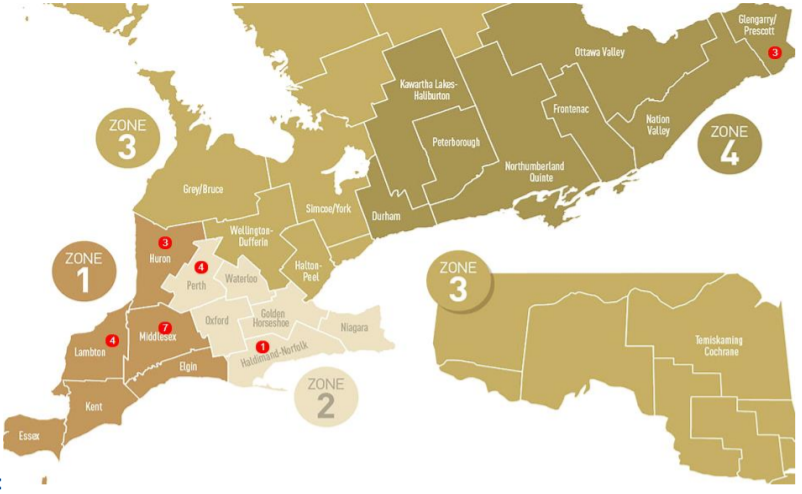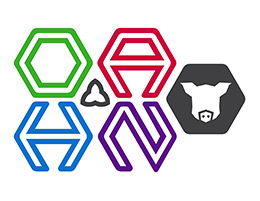Ontario Animal Health Network (OAHN) Swine Network Quarterly Producer/Industry Report
Porcine Epidemic Diarrhea virus (PEDV) in Ontario Update
Dr. Tim Pasma reported that there were 18 new sites detecting PEDV in Q1 that includes 4 sow herds, 11 grow-finish herds and 3 finisher. The first case in Q1 was reported on Jan. 18, 2020 and signaled the beginning of this outbreak. Some connections have been made to an assembly yard point of contact, transport and to shared staffing resources. There were no new Porcine Deltacoronavirus (PDCoV) sites reported in Q1. Since the end of Q1 new site detections with PED have continued and are reflected in the map below.

Image Source:
Swine Health Ontario Website: http://www.swinehealthontario.ca/Disease-Information/PED-Tracking-Map?y=2020
As of March 31, 2020 OMAFRA will no longer be following up on PEDV or PDCoV traceback investigations for sites located in Ontario. Both pathogens will remain on the immediately notifiable disease list, so veterinarians are still obligated to report new sites to OMAFRA. Swine Health Ontario (SHO) and Ontario Pork (OP) have worked with OMAFRA to develop a transition
strategy that should be communicated in the next few weeks.
Senecavirus A (SVA) OAHN Project Findings
Dr. Ryan Tenbergen provided an update on the findings of the OAHN SVA Project:
- Maternal antibodies in due to be weaned pigs gradually rose until about 6 weeks following the initial outbreak. There was a decline at 8 weeks and then the levels rose to 14 weeks.
- The number of pigs testing positive for SVA maternal antibodies at weaning was very variable throughout the entire testing period.
- Gilts took about 11 days after exposure to feedback to seroconvert.
- Oral fluids (saliva) testing in the nursery was performed on 12 ropes per 2000 pigs. It was anticipated that the number of positives might have been higher. Perhaps 12 ropes per barn was not quite sensitive enough to pick up on all of the populations that were truly virus positive. The first group was negative at 7 weeks post outbreak but then there were positives up to 10 weeks
post outbreak in other groups. - Similar testing with 12 ropes per barn was done post entry to finisher and the results of that testing was also variable. Groups of pigs intermittently tested positive up to 15 weeks after the outbreak but all populations were negative after 15 weeks.
- There were some batches that tested positive on entry to the nursery, negative at the end of nursery and for some unknown reason tested positive as soon as 1 week post entry to the finisher. It has been speculated that stress associated with shipping may cause another period of viral shedding and this has been seen in sows shipped to market.
- From July 5 to September 9 all finishers were tested before they started to market pigs. There was a visual inspection to confirm that there were no blister-like lesions. All barns were negative for SVA based on negative oral fluids prior to shipping.
- Farrowing rooms started to test negative for SVA virus at 16 weeks post outbreak.
- This SVA isolate did not appear to be closely related to other Canadian strains and did not appear to be related to viruses recorded in Genbank an international database.
- Final testing of the sow barns was completed in April which was 15 to 17 weeks after gilts were entered. All of those blood tests were negative providing evidence that the eradication may be successful, but continued testing is planned.
- Boar semen was not tested because the “in barn” boars were not trained for on farm semen collection.
OAHN Swine Small Herd Postmortem Project
Dr. Josepha Delay provided an update on the OAHN Swine Small Herd PM Project:
- The goal of the project is to expand the lines of communication to small scale swine operations
in order to increase awareness of foreign animal and zoonotic diseases (diseases that can be
transferred from animals to people and vice versa). - The participating herds will have 50 sows or less or will market less than 1000 market hogs per
year. - Herds must have a premises identification (PID) and a herd veterinarian in order to enroll in the
project. The producer/owner must agree to complete a herd management survey. - The project will start accepting cases on May 15. Post mortems will preferably be performed at
AHL, but field post mortems can be enrolled as necessary. Testing will be standardized by
disease syndrome affected and age group. - If you are interested in participating please contact Josepha DeLay at jdelay@uoguelph.ca
OAHN Wild Swine Ministry of Natural Resources and Forestry (MNRF) Project Update
Dr. Erin Koen provided an update on the OAHN Wild Swine Project:
- One project objective is to be better prepared for dealing with the risks of disease transmission presented by wild swine in the event of an foreign animal disease such as African Swine Fever. Wild swine movement is related to the availability of suitable habitat that allows for migration of populations to new locations.
- Reported sightings are assessed for validity and observations are entered into a database that is under development.
- Currently using a network approach to produce a “heat map” that indicates hot spots of potential disease transmission due to wild pigs in Ontario. Most wild pig sightings collected over the last year have been escaped domestic pigs. These areas would be at greatest risk to disease transmission including ASF if it is ever detected in Ontario.
- There are currently 238 unverified wild pig sightings that have been collected in Ontario. Some of these are older sightings. Most photos submitted of pigs in the wild appear to be common breeds of domestic pigs. Occasionally a skull found in the wild looks very much like a Eurasian wild boar. Eastern Ontario has had more sightings in the past although those sightings have tapered off over the last couple of years.
- Producers and pig owners must remember the importance of never releasing domestic pigs or Eurasian wild boar into the wild and the importance of finding and retrieving all escapees.
COVID-19 compared to African Swine Fever (ASF) virus
Dr. Al Scorgie provided a research overview on how Covid-19 compares to ASF:
Where COVID-19 and ASF virus compare- Source: Pig Progress Mar 9, 2020
- A reporter for Pig Progress wrote an article comparing the similarities between COVID-19 and ASF virus. Interesting fact is that this was written BEFORE things started to intensify with Covid-19.
- Similarities between both viruses include:
➢ Vast amounts of events have been postponed for both viruses worldwide
➢ Virus isolation for both leads to sudden panic
➢ Absence of a vaccine
➢ Mapping and reporting outbreaks worldwide - One major difference between these two viruses is that ASF causes almost 100% mortality in affected pigs vs. COVID-19 can be virtually undetected in some humans making the case numbers inaccurate.
Lessons learnt: It is never too early to start planning for a virus detected somewhere else in the world!
Can COVID-19 (SARS-CoV-2) infect pigs?
- The Friedrich Loeffler-Institute in Germany, has released preliminary results of studies that show that pigs are not susceptible to the COVID-19 virus.
How can producers engage in OAHN?
- Read our quarterly producer reports and let us know what you think!
- Discuss the material included in these reports with you herd veterinarian and other swine producers. Help us spread the word!
What to do if you see feral pigs in Ontario…
- OMAFRA is working with the Ministry of Natural Resources & Forestry (MNRF) to put together a wild swine strategy for Ontario. The first step will be to try to identify wild swine within Ontario.
- The MNRF has set up a page on iNaturalist at: www.inaturalist. org/projects/ontariowild-pig-reporting for residents to document any possible wild pigs in Ontario. Sighting information can also be emailed to MNRFSpeciesConservationPolicyBranch@ontario.ca.


